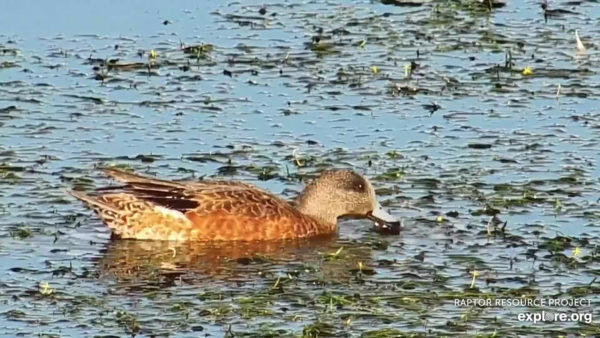Information About The Bird
Seen/Heard at
Mississippi River Flyway
General Description
American Wigeons are medium-sized ducks with short bills and round heads. They often sit low in the water and tuck their heads in, which can make it appear like they don’t have necks. Females and non-breeding males have brown bodies, brownish-grey heads, and a dark smudge around their eyes. Breeding males have a brownish head with a wide green stripe behind the eye and a white crown. Their bodies are light brown or cinnamon with white patches on the sides of the rump and black undertail feathers. Flight reveals a white patch on their upperwings and a green patch on their secondaries. Regardless of sex or breeding status, American Wigeons have a pale gray or bluish bill with a black tip.
A lot of the ducks we see on the Flyway in spring and fall have either molted or are in the process of molting, which can make identification a little tough. In this case, the distinctive bill color, round head, and dark eye smudge were very useful field marks. While the male has his neck extended, the female is floating in a classic American Wigeon head-pulled-down pose: another helpful field mark.
Diet
American Wigeons are omnivores, although they eat primarily plant foods. Their diet includes pondweeds, wigeon grass, eelgrass, duckweed, wild celery and wild rice (both grow in abundance here), elodea, water milfoil, and terrestrial plants like clover, cultivated rice, wheat, and barley.
Dabbling ducks like American Wigeon require shallow water to feed and raise young. Since they don’t dive, they are unable to feed in deep water, although they can forage on land. Diving ducks like Mergansers can feed in deep water, but have a hard time foraging on land. You can learn more about waterfowl feeding adaptations here: https://www.ducks.org/conservation/waterfowl-research-science/waterfowl-feeding-adaptations.
Nesting
American Wigeon build nests on dry ground, concealing them under bushes, shrubs, or clumps of vegetation. The female digs a shallow scrape and lines it with dry grass, stems, down, and feathers. She will typically produce one clutch of three to twelve creamy white eggs per year, although she may lay a second clutch if her first clutch is destroyed. Females incubate eggs for 25 to 28 days and young leave the nest for the first time within 24 hours of hatch. Females attend broods for six to seven weeks: males guard females during incubation but don’t incubate and typically leave once incubation is completed.
Citations and attributions
Digital Distribution Maps of the Birds of the Western Hemisphere, version 1.0. NatureServe, Arlington, Virginia, USA. Data provided by NatureServe in collaboration with Robert Ridgely, James Zook, The Nature Conservancy – Migratory Bird Program, Conservation International – CABS, World Wildlife Fund – US, and Environment Canada – WILDSPACE.
Web Link: http://bit.ly/2ynPQ5I
The Cornell Lab of Ornithology Birds of North America: https://birdsna.org/Species-Account/bna/species/amewig/introduction
All About Birds: https://www.allaboutbirds.org/guide/American_Wigeon/lifehistory
Migration
Spring migration begins in February, with most birds arriving at breeding grounds by mid-May. Fall migration begins in August, with most birds arriving on their wintering grounds by early December. Birds from Canada migrate down the Mississippi River, past our camera, to New Mexico, Louisiana, and the Gulf Coast of Mexico. Pair formation begins before arrival on wintering grounds and continues through the winter.
Measurements
Cornell describes the American Wigeon as being larger than a Green-winged Teal, but smaller than a Mallard. The widgeon’s tucked-in, compact floating style can make it appear smaller than it really is.
Both Sexes
Length: 16.5-23.2 in/42-59 cm
Weight: 19.1-46.9 oz/540-1330 g
Wingspan: 33.1 in/84 cm
Wing Design: High Speed
The American Wigeon has long, flat, wings that taper to a point for fast takeoffs and twisting flight to dodge obstructions and predators. You can learn more about duck wings here: https://www.ducks.org/conservation/waterfowl-research-science/wings-in-action.
| See also different: | Dabbling Ducks, Mississippi River Flyway |
